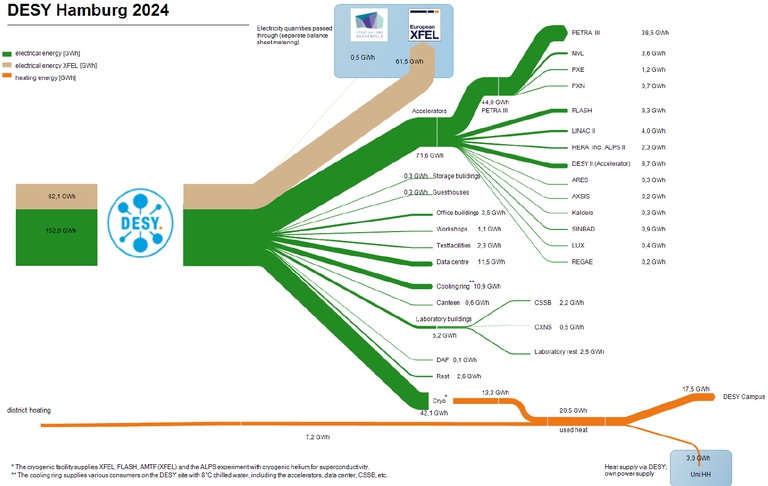Energy consumption at DESY
Sustainability
Energy consumption at DESY
Although supplying electricity to its various machines accounts for the largest energy demand at DESY, energy at DESY is not restricted to electrical power. It also includes supplying heat, as well as cooling and water. The extent to which the various energy/media flows play a role at DESY is explained in the following sections.
Electrical energy
The greatest demand for energy at DESY takes the form of electrical power. This is used to run its accelerators. The accelerators currently in operation are LINAC, DESY II, FLASH I+II and PETRA III. In recent years, the consumption of electrical power has been around 150 gigawatt-hours (GWh); if the consumption of XFEL is included, it amounts to about 210 GWh.
DESY also operates an organisational load management system. This allows smoothing out large power peaks in electricity consumption.
Electricity from renewable energies
As early as 2020, it was decided within the framework of the comprehensive energy concept at DESY to switch completely to green electricity as from the next procurement period, starting in 2023.
Heat
The heat required on the DESY site for heating and air conditioning is provided by district heating, among others. For this purpose, DESY has its own local heating network which connects the campus. Heat is fed into this network from Hamburg’s district heating network.
In addition to the district heating, heat is recovered from the cryogenics plant, i.e. the low-temperature refrigeration plant.
This waste heat accounts for approximately 50% of total demand. A brief description is available at energy efficiency projects (renew link when website goes live).
Cooling
Alongside the local heating network, DESY also operates a cooling network. This makes it possible to supply cold water from a total of three cooling centres to a number of different consumers (computer centre, accelerators, laboratory buildings, etc.). The advantage of this is that not every consumer needs a chiller, and large systems can be operated much more efficiently. The three cooling centres are connected via the cooling network, hence the term “cooling ring”. This cooling ring has been fully operational since the beginning of 2016.
During the cold season free cooling can be used to reduce energy consumption. This is already being implemented in the case of the FLASH II accelerator. Here, the accelerator’s 20°C cooling circuits switch to free cooling once outside temperatures drop below 15°C. The cooling water is cooled down in cooling towers, with the help of ambient air and fans. This only consumes small amounts of electrical power compared with the chillers that otherwise cool the water.
Water
Water is used for various purposes at DESY. On the one hand, it is used to operate sanitary facilities and kitchens and, on the other hand, to cool the accelerators. The water that DESY needs in the form of drinking water is purchased from the municipal supplier. Most of the water required for cooling its accelerators is obtained by DESY itself, from five wells located around the DESY site. The water from the wells is deionised in our own water treatment plant and used as deionised (fully demineralised) water. In 2022, for example, 15% of DESY’s water needs were procured from the supplier, while 85% came from its own wells.
Energy consumption at DESY is documented and visualized by the energy monitoring.
Data visualization

Sankey diagram electricity and heat consumption 2024 at DESY Hamburg in gigawatt-hours (GWh). Decimal places are separated by a comma.
This graph shows the electricity and heat consumption for DESY Hamburg in 2024. DESY and XFEL together consume 214.1 GWh of electricity. Of this, 152 GWh will go to DESYs operations. The largest share of 71.6 GWh at DESY is consumed by accelerators such as PETRA III, FLASH, DESY II and LINAC II together with the experiments running there. The cryogenics facility, the computer center and the cooling ring also have a large demand for electricity with a total of 64.5 GWh. The general infrastructure buildings, such as the canteen and storage facilities, require a total of 16 GWh of electricity.
The heat supply on campus also includes the supply for the university buildings. A total of 20.5 GWh is required for this - 17.5 GWh for DESY itself. DESY can cover the majority of its heat supply with waste heat from the cryogenics plant. In 2024, this was 13.3 GWh. The remaining 7.2 GWh is provided by district heating.
These links will take you to the individual websites of the experiments and facilites shown:
PETRA III (Positron-Elektron-Tandem-Ring-Anlage)
MvL (Max von Laue hall)
PXE (PETRA X-tention East / Ada Yonath hall)
PXN (PETRA X-tention North / Paul P. Ewald hall)
FLASH (Free-electron laser Hamburg)
LINAC (Linear Accelerator) (german)
HERA (Hadron-Elektron-Ring-Anlage) (german)
ALPS (Any Light Particle Search)
DESY II (german)
ARES (Accelerator Research Experiment at SINBAD)
AXSIS (Attosecond X-ray Science: Imaging and Spectroscopy)
Kaldera (Plasma Accelerator)
SINBAD (Short INnovative Bunches and Accelerators at DESY)
LUX (Large Underground Xenon)
REGAE (Relativistic Electron Gun for Atomic Exploration)
DAF (Detector Assembly Facility)
CSSB (Center for Structural Systems Biology)
CXNS (Centre for X-ray and Nano Science)
Cryo (Cryogenics plant)